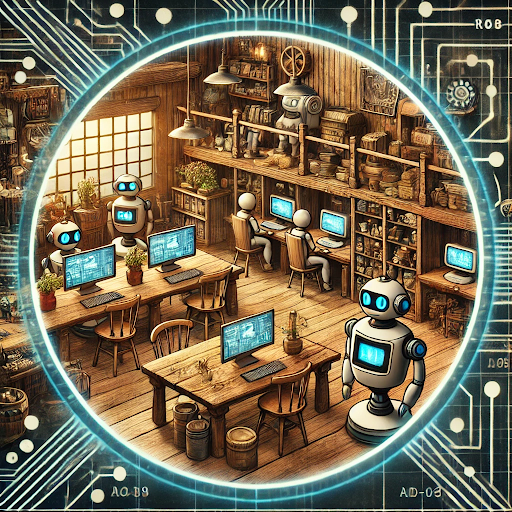
As technology advances at a rapid pace, businesses around the globe are scrambling to adapt to innovations that can streamline operations, enhance customer experience, and improve decision-making. The road to this transformation is often lined with strategic shifts, emerging tools, and evolving methodologies. In this dynamic landscape, the mechanisms by which businesses operate are becoming increasingly efficient, paving the way for revolutionary shifts in traditional workflows.
Evolution of Operational Efficiency
Businesses today are not what they were even a decade ago. Traditional models, which were once primarily driven by human expertise and intuition, are now blending that human touch with powerful technological solutions. From retail and manufacturing to finance and healthcare, efficiency no longer comes solely from manual oversight or simple automation. Instead, enterprises are leveraging tools that enable them to not only automate but also predict outcomes and self-optimize.
At the heart of this transformation is the notion of intelligence—not human intelligence alone but a fusion of it with cutting-edge technological innovations. These intelligent systems have given rise to solutions that are no longer simply reactive but proactive in addressing organizational needs. The impact of these systems isn’t just about doing more in less time but also about ensuring higher accuracy, consistency, and adaptability.
Unlocking Innovation Through Automation
One of the most significant innovations shaping modern enterprises is the shift from simple task-based automation to more dynamic and adaptable systems. Companies are finding ways to go beyond repetitive, rules-based processes, moving toward automated solutions that can analyze vast data sets, learn from past interactions, and make independent decisions.
For example, consider a large financial institution that processes thousands of customer transactions daily. Simple automation tools can handle routine tasks, like processing loan applications or updating customer details. But what if there’s an anomaly in a customer’s transaction history that requires nuanced decision-making? This is where sophisticated systems, such as AI-powered solutions, come into play—enhancing operational accuracy by identifying risks and alerting human supervisors when necessary.
This combination of human oversight with AI-based automation creates a synergy that enhances efficiency and reliability while allowing companies to innovate faster and scale their operations seamlessly.
Data as the Driving Force
The effectiveness of modern business operations increasingly relies on how well they utilize data. Data has become more than just an asset—it’s the foundation for meaningful insights that fuel strategy, innovation, and execution. But raw data is of little value without proper processing, analysis, and contextual understanding. This is where advanced systems, including those driven by AI agents, come into play.
Modern enterprises generate vast quantities of data, from customer interactions and financial transactions to supply chain activities. Harnessing this data requires sophisticated tools capable of processing information in real time, identifying patterns, and making informed decisions based on those patterns.
For example, predictive maintenance in manufacturing relies on sensors and data collected from machinery. By analyzing this data, AI-powered systems can predict when a machine might fail and trigger maintenance activities before issues escalate. Similarly, in marketing, data-driven insights can enable targeted campaigns tailored to individual consumer behavior, increasing engagement and conversion rates.
Data is no longer just about what has happened in the past—it’s a means to anticipate what could happen next and take preventive or opportunistic action accordingly.
Enhancing Customer Experience Through Intelligence
In a world where customer expectations are higher than ever, businesses are under pressure to deliver not only products and services but also memorable experiences. Personalized interactions, quick problem resolution, and seamless communication channels are now prerequisites for customer satisfaction.
Organizations are turning to intelligent systems to enhance their customer experience strategies. AI agents, for example, play a crucial role in enabling dynamic customer interactions. Whether through chatbots, recommendation engines, or self-service portals, these systems provide real-time assistance, gather feedback, and continuously learn from interactions to improve future engagements.
Consider a retail brand with an online presence. A customer browsing the website may receive personalized product recommendations based on their browsing history, purchase behavior, and demographic profile—all thanks to data-driven systems that analyze this information in real time. AI agents ensure a personalized and efficient customer journey by providing timely support and eliminating friction points.
Redefining Workforce Roles
The widespread integration of intelligent systems has raised concerns about job displacement and redundancy. However, a more nuanced perspective reveals that technology isn’t replacing workers—it’s reshaping their roles and responsibilities. Employees can focus on higher-value tasks such as creative problem-solving, strategy development, and customer engagement while leaving repetitive, time-consuming tasks to automation.
Many organizations have found that augmenting their workforce with intelligent solutions leads to a more engaged and satisfied workforce. Employees feel empowered when they can rely on tools that eliminate mundane tasks and give them the bandwidth to innovate and collaborate effectively.
Take the example of customer support teams. While AI-driven chatbots handle routine inquiries, human agents can focus on complex cases requiring empathy and critical thinking. Similarly, in industries like finance, automated systems can handle data-intensive tasks such as compliance checks, freeing up analysts to provide strategic insights.
Challenges and Considerations
While the benefits of intelligent systems are numerous, organizations must navigate certain challenges to fully realize their potential. Data privacy and security are top concerns, particularly when dealing with sensitive information. Companies must ensure robust security measures and compliance with regulations to protect both organizational and customer data.
Moreover, the effectiveness of these systems largely depends on their design and implementation. A poorly implemented solution can lead to inefficiencies or unintended consequences, such as biased decision-making or inaccurate predictions. To mitigate these risks, businesses must invest in thorough planning, regular audits, and continuous improvement.
Additionally, fostering a culture of collaboration between technology and human expertise is essential. Organizations must provide adequate training and support to help employees adapt to new tools and workflows, ensuring a seamless transition and sustainable growth.
The Road Ahead
The ongoing evolution of technology will continue to reshape how businesses operate, compete, and innovate. Companies that embrace these changes and invest in the right tools and strategies will be well-positioned to thrive in an increasingly competitive landscape. The integration of intelligent systems, data-driven insights, and a collaborative workforce will be critical components of this journey.
As the future unfolds, enterprises will likely encounter new challenges and opportunities. But one thing remains clear: the fusion of human intelligence with cutting-edge technology will define the success of organizations aiming to stay ahead of the curve.

Creative Ways to Utilize Business Signage Beyond Branding

How to Identify the Best Watch Brands for Investment

Why Your Company Should Join Hands With Ruby Digital?

Pre-Requisites Before Applying for an Instant Personal Loan

Embrace the Magic of Turkey: An Unforgettable Visit

13 Best Content Marketing Companies in 2025 to Watch Out For

Rent Gaming Laptop with Guaranteed Best Rates and Flexible Rental Options









